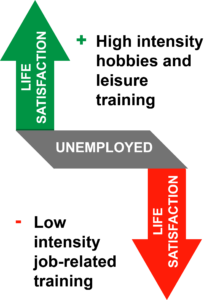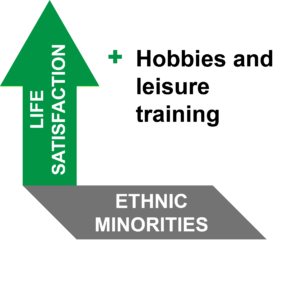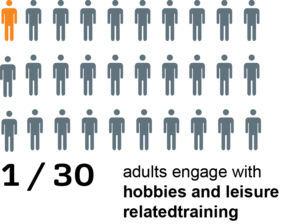Can adult learning lead to higher life satisfaction?
Life satisfaction gains from adult learning
The big questions:
Do adults who are:
- unemployed
- living in deprived areas
- hold no/low qualifications
- part of minority ethnicities
gain wellbeing benefit from participating in learning programmes? And, if so, what type of adult learning has the biggest impact?
Evidence shows that high-quality learning has a wide range of benefits for the wellbeing of different individuals. But is there a link between adult learning and life satisfaction? Can the positive impact of learning on life satisfaction be replicated nationally?
The research
- Longitudinal data from the UK Understanding Society Survey between 2010 and 2014.
- People over 16 living in England, and not in full time education.
- 35,146 individuals tracked over four time periods.
What types of learning were included in the research?
 Job-related training – this may be mandatory, or may be a condition for welfare benefit entitlement or progression to other courses.
Job-related training – this may be mandatory, or may be a condition for welfare benefit entitlement or progression to other courses.
 Hobby and leisure training – This type of training could range from night classes on photography, crafts, information technology skills, music making, ‘Do-it-yourself’ or lifestyle course.
Hobby and leisure training – This type of training could range from night classes on photography, crafts, information technology skills, music making, ‘Do-it-yourself’ or lifestyle course.
Note: we know very little about the precise nature of all the training undertaken by participants in the studies. These courses could be introductory but could also be highly advanced.
The evidence
There are low numbers of adults participating in training activities. Around 20% of adults engage with job-related training and 3% with hobbies and leisure related training.
Training intensity (how long it lasts) can make a difference
When it comes to people who are unemployed:

- Low intensity job-related training can reduce life satisfaction.
- High intensity hobbies and leisure training can boost life satisfaction

- For those in employment high intensity training can boost life satisfaction.

Younger adults (16 to 24 years) both win and lose from job-related training
- Low intensity training results in a decline in life satisfaction for younger adults.
- High intensity job-related training boosts life satisfaction for young adults.
Qualification level of participants can affect wellbeing impact
Those with vocational qualifications as their highest award experience a reduction in life satisfaction from low intensity job-related training. Those with low qualification levels report hobbies and leisure training as an important source of life satisfaction.

Area deprivation affects which type of training has a positive wellbeing impact
When it comes to training in different areas of deprivation:
- For those living in medium and highly deprived areas of England, training is an important source of life satisfaction.
- The greatest boost to life satisfaction for those in deprived areas of England are from hobbies and leisure training.

Ethnic minority groups get a wellbeing benefit from hobbies and leisure
Ethnic minority groups received a life satisfaction boost from hobbies and leisure training, while job-related training showed no difference in impact across the groups. Unfortunately, It was not possible to dis-aggregate different ethnicities within this group from the data.

How can policymakers and learning providers turn evidence into action?
- Access to hobbies and leisure training may be of particular benefit to the life satisfaction of people who did not get formal qualifications earlier in life or those who have gained qualification through vocational learning modes. This is true across all age groups.
- Access to hobbies and leisure training may be of particular benefit to the life satisfaction of people living in the most deprived areas of the UK and those who are unemployed. High intensity hobbies and leisure training can boost life satisfaction for the unemployed and in so doing, this form of training may operate as an important input for developing personal resources (e.g. self-esteem, social networks, daily structure and purpose) that may aid transition into future employment.
- High intensive job-related training may be of particular benefit to the life satisfaction of the unemployed and young people. While low intensity job-related training is related to a decrease in life satisfaction. As low intensity training is less likely to be formal training, i.e., resulting in a qualification, this pattern might suggest that the lack of qualification in low intensity training is failing to meet expectations or needs for the participants.


